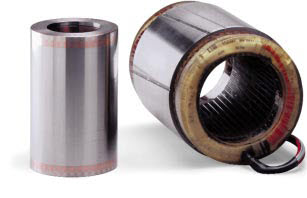|
|
|
|
 Home > Products > Machine Components > Home > Products > Machine Components > |
 |
 작성일 : 09-09-17 16:07
작성일 : 09-09-17 16:07
|
[HF Rotor/Stator Unit] MOOG Brand Rotor Stator
|
|
|
글쓴이 :
관리자
 조회 : 12,442
|

Unita Rotostatoriche Alta Frequenza
High Frequency Rotor/Stator Units
CARATTERISTICHE GENERALI - GENERAL CHARACTERISTICS
Il progetto di tutte le nostre configurazioni
elettromagnetiche ? eseguito dal nostro reparto
Ricerca & Sviluppo, presso lo stabilimento di
Casella, con i piu avanzati strumenti di calcolo e di
simulazione, supportati da un’esperienza
ultratrentennale.
Progettazione elettromagnetica
Ogni progetto ottimizzato con un “Programma di
calcolo elettromagnetico agli elementi finiti” che
permette di ottimizzare le caratteristiche
elettromagnetiche in tutte le condizioni reali di
funzionamento; la figura 1 mostra la distribuzione
del flusso all’interno dell’insieme statore/rotore.
Un secondo programma, completato
internamente, permette di valutare le prestazioni
del motore in termini di tensione, potenza,
corrente, giri, sovraccaricabilit?, perdite ecc.
calcolando inoltre tutte le grandezze del circuito
equivalente per la corretta impostazione dei
parametri necessari agli azionamenti a controllo
vettoriale.
Progettazione meccanica
Il “Programma di calcolo meccanico agli elementi
finiti” consente di calcolare con precisione la
sollecitazione meccanica del lamierino rotore per
effetto della forza centrifuga e dell’interferenza
rotore / albero; la fig. 2 evidenzia la distribuzione
delle sollecitazioni all’interno del rotore.
Completano la progettazione meccanica il
“Programma di calcolo dell’interferenza minima
necessaria di calettamento rotore albero” e il
“Programma di calcolo della frequenza critica
flessionale della linea d’asse rotore/albero
mandrino”.
Caratterizzazione
Tutti i Programmi di calcolo indicati sono stati
affinati attraverso continue prove di validazione,
effettuate sia al nostro interno sia con i Clienti
nella configurazione finale dell’elettromandrino.
Ogni famiglia d’unita rotostatoriche ? qualificata
da severi test nel nostro laboratorio prove che
dispone, fra gli altri, di un banco da 30kW a
30.000 r/min, particolarmente adatto per prove a
carico su elettromandrini.
I dati forniti nei nostri cataloghi sono, quindi,
diretta conseguenza delle caratterizzazioni
potenza/velocit? eseguite nel nostro laboratorio.
Product Desigh
The design of all our electromagnetic configurations
is the result of the extensive experience of the
Vickers Casella Research & Development
department that was established in the 1960’s. Our
designs have been refined and improved over the
years by our continued use of the most advanced
calculation and simulation computer based software
tools.
Electromagnetic design
A “Finite Element Program” optimises the
electromagnetic characteristics in accordance with
real-world working conditions; fig. 1 shows the
internal distribution of the flux within the system
stator/rotor.
Another software tool developed by Casella,
evaluates the performances of the motor in terms of
voltage, power, current, speed, overloads, losses
etc. also calculating all the parameters of the
equivalent circuit and fundamental input data for
vectorial control drives.
Mechanic design
The “Finite Element Program” allows the precise
evaluation of both the mechanic stresses,
caused by centrifugal forces in the rotor laminations,
and of the correct interference fit for the rotor and
shaft sub-assemblies; fig. 2 shows the internal
distribution of stresses in the rotor. By using the
results from the program that calculates the minimum
value of the necessary interference for the rotor and
shaft assembly and those from the program that
calculates the spindle’s axis line critical bending
frequency, we can complete the mechanical design.
Evaluation testing
All the above mentioned calculation programs are
continuously updated and improved as a result of
continuous product evaluation and testing, from both
our Test Department and feedback from our Clients’
who carry out the final configuration of the electric
spindle.
Each rotor/stator unit family has to pass extensive
test regimes in our laboratory on dedicated test
benches. In particular, we have a 30 kW - 30,000 rpm
test bench which is dedicated to load testing of
electric spindles. Consequently, all the data stated in
our catalogues can be verified by correlation with
data from the above mentioned sources.

Banco prova 30 kW a 30.000 r/min
Test bench 30 kW at 30,000 rpm

Banco prova 36 kW a 7.000 r/min, 300 Nm
Test bench 36 kW at 7,000 rpm, 300 Nm

Banco prova 100 kW a 3.000 r/min, 1.500 Nm
Test bench 100 kW at 3,000 rpm, 1,500 Nm
|
|
|
|

